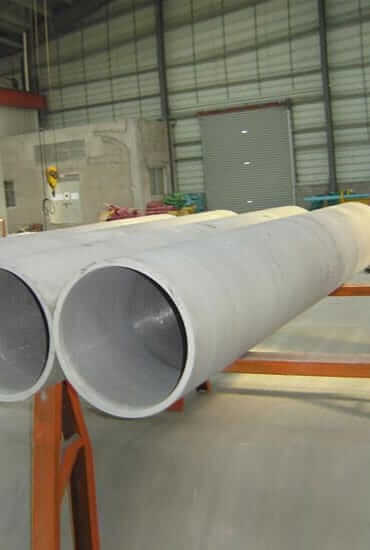vishal@solitaire-overseas.com
Stainless Steel 316 / 316L Stainless Steel Pipe supplier
316 Stainless Steel Pipe
What Is 316L Stainless Steel Pipe?
316 / 316L Stainless Steel Pipes
316 and 316L stainless steel pipes offer superior corrosion resistance, excellent strength, and weldability. Ideal for marine, chemical, and industrial use, these pipes ensure durability and performance in harsh environments. Available in seamless and welded.
316 / 316L Stainless Steel Tubes
316 and 316L stainless steel tubes provide outstanding corrosion resistance, high strength, and excellent weldability. Suitable for marine, pharmaceutical, and chemical industries, they ensure reliable performance in demanding environments.

316 Stainless Steel Pipe & 316L Stainless Steel Pipe Specifications
International standards guaranteeing performance and quality in 316 and 316L stainless steel pipes include ASTM A312, A213, A269, and A249. They are identified as UN S 31600 (316), S 31603 (316L), European EN 1.4401 and EN 1.4404. Additionally tracked for dimensional accuracy and structural consistency are DIN 17456 and DIN 17458. For a range of uses, these smooth, welded pipes with plain or beveled ends are offered in SCH 5 through SCH XXS.
Specifications
Dimensions
Seamless Pipe Size
ERW Pipe Size
EFW Pipe Size :
Outside Diameter :
Length
Thickness
Schedule
Type
Form
End
| STANDARD | WERKSTOFF NR. | UNS | JIS | BS | GOST | AFNOR | EN |
| SS 316 | 1.4401 / 1.4436 | S31600 | SUS 316 | 316S31 / 316S33 | - | Z7CND17‐11‐02 | X5CrNiMo17-12-2 / X3CrNiMo17-13-3 |
| SS 316L | 1.4404 / 1.4435 | S31603 | SUS 316L | 316S11 / 316S13 | 03Ch17N14M3 / 03Ch17N14M2 | Z3CND17‐11‐02 / Z3CND18‐14‐03 | X2CrNiMo17-12-2 / X2CrNiMo18-14-3 |
Chemical Composition of 316L and 316 Stainless Steel Pipes
316 and 316L stainless steel pipes are identical even if their chemical compositions differ. Strength and resistance against corrosion rise with 16–18% chromium, 10–14% nickel, and 2–3% molybdenum. 316L boasts 0.03% carbon to stop welding carbide precipitation. 316 has the highest carbon content—0.08%. Chemical properties let materials withstand demanding industrial, marine, and chemical treatment.
| Element | SS 316 | SS 316L |
| C | 0.08 max | 0.035 max |
| Mn | 2.0 max | 2.0 max |
| Si | 1.0 max | 1.0 max |
| P | 0.045 max | 0.045 max |
| S | 0.030 max | 0.030 max |
| Cr | 16.00 - 18.00 | 16.00 - 18.00 |
| Mo | 2.00 - 3.00 | 2.00 - 3.00 |
| Ni | 11.00 - 14.00 | 10.00 - 14.00 |
| Fe | 67.845 min | 68.89 min |
Properties of 316 and 316L Stainless Steel Pipe
In situations with acidity and salt, 316 and 316L stainless steel pipes hold good resistance against corrosion. Their mechanical durability and tensile strength help them to manage high temperatures and stress. Enhanced 316L weld sensitivity resistance. These grades resist pitting and crevice corrosion for long-term performance in demanding conditions. They are appropriate for low-permeability use as, annealed, they are non-magnetic.
| Element | SS 316 | SS 316L |
| Density | 8.0 g/cm3 | 8.0 g/cm3 |
| Melting Point | 1400 °C (2550 °F) | 1399 °C (2550 °F) |
| Tensile Strength | Psi – 75000 , MPa – 515 | Psi – 75000 , MPa – 515 |
| Yield Strength (0.2%Offset) | Psi – 30000 , MPa – 205 | Psi – 30000 , MPa – 205 |
| Elongation | 35 % | 35 % |
Applications of 316 & 316L Stainless Steel Pipes
- Chemical Industry – Ideal for transporting acids, chemicals, and solvents.
- Marine Environments – Used in seawater systems, shipbuilding, and offshore platforms.
- Food & Beverage – Perfect for sanitary piping and processing lines.
- Pharmaceuticals – Suitable for cleanroom piping and sterile applications.
- Architecture & Construction – Used in handrails, structural supports, and façades.
- Power Plants – Handles high-pressure steam and hot water lines efficiently.
Solitaire Overseas is a reputable worldwide provider and exporter if you search for dependable 316 and 316L stainless steel tubing. They supply tailored sizes, finishes, and lengths to fit particular industrial needs as well as pipes that follow international standards. Every product is meticulously wrapped for worldwide delivery and carries required certifications like EN 10204 3.1/3.2. Strong reputation for quality and fast delivery helps Solitaire Overseas to guarantee customers get durable, corrosion-resistant stainless steel pipes for important uses.


 Table of Content
Table of Content
 India
India Iran
Iran Thailand
Thailand South Korea
South Korea Turkey
Turkey Morocco
Morocco Costa Rica
Costa Rica Kazakhstan
Kazakhstan Philippines
Philippines Canada
Canada Japan
Japan Russia
Russia United States
United States Saudi Arabia
Saudi Arabia Kuwait
Kuwait Singapore
Singapore Malaysia
Malaysia UAE
UAE Germany
Germany Italy
Italy China
China UK
UK Egypt
Egypt Vietnam
Vietnam Oman
Oman Australia
Australia Qatar
Qatar Portugal
Portugal Nigeria
Nigeria Iraq
Iraq Ukraine
Ukraine Bangladesh
Bangladesh Poland
Poland Romania
Romania Cyprus
Cyprus Angola
Angola Colombia
Colombia Norway
Norway Chile
Chile Mexico
Mexico South Africa
South Africa Netherlands
Netherlands Brazil
Brazil France
France Jordan
Jordan Spain
Spain Hong Kong
Hong Kong Indonesia
Indonesia Taiwan
Taiwan Tobago
Tobago Greece
Greece Czechia
Czechia Belgium
Belgium Sri Lanka
Sri Lanka Myanmar
Myanmar Venezuela
Venezuela